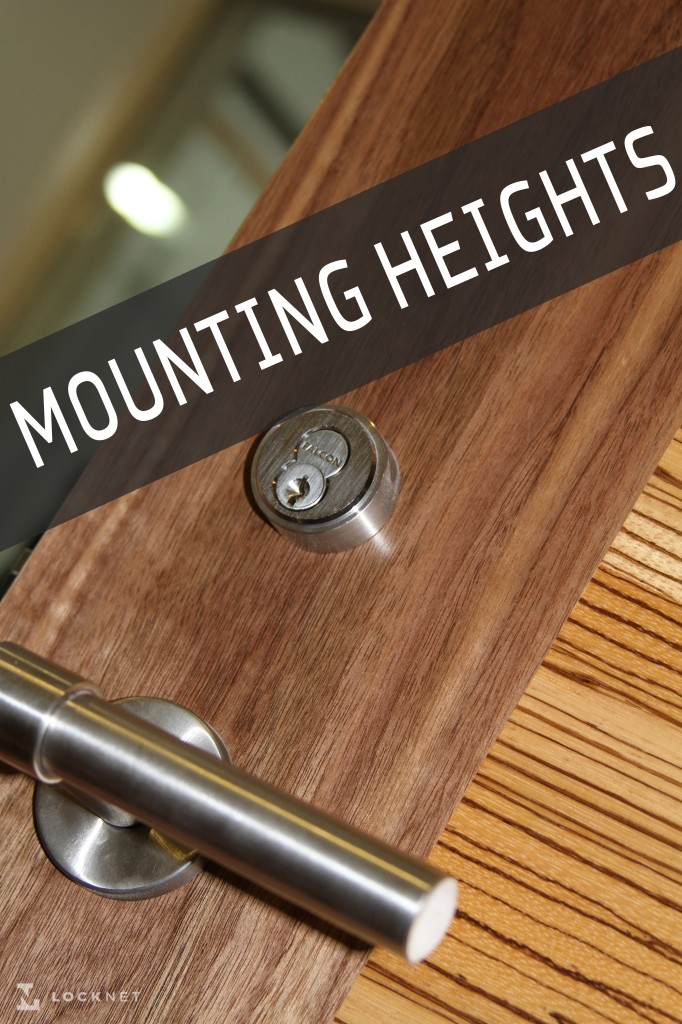I’m new to the industry and door hardware mounting heights seems to be Code 101. I’ve only found a handful of useful articles online but they’re scattered in a few different places and regularly contradict each other. What’s the no-nonsense version of door hardware mounting heights?
 You are not the only person with this problem! In fact, Katie re-published an article from Lori Greene of iDigHardware on mounting heights in 2012 after regularly referencing it. Here’s a quick excerpt from that article:
You are not the only person with this problem! In fact, Katie re-published an article from Lori Greene of iDigHardware on mounting heights in 2012 after regularly referencing it. Here’s a quick excerpt from that article:
Each of the codes and standards pertaining to door openings contains slightly different language regarding mounting heights of operating hardware. Generally, hardware must be mounted between 34” and 48” above the finished floor or ground, with exceptions for (a) locks used only for security purposes, and (b) operating hardware on doors leading to swimming pools. But, in order to determine how the codes apply to your specific project, it’s important to understand how the standards differ.
The International Building Code (IBC) (all editions to date) requires operating hardware for most egress doors to be mounted between 34” and 48” above the finished floor (AFF). Locks used only for security purposes and not used for normal operation are excluded.
The language pertaining to “locks used only for security purposes” isn’t very specific, which leaves this up to interpretation by the Authority Having Jurisdiction (AHJ). The IBC Commentary gives the example of an unframed glass door at the front of a tenant space in a mall, with a lock in the bottom rail. Deadbolts mounted at other heights may be accepted by the AHJ, depending on the occupancy type.
Door Hardware Mounting Heights – 2010 ADA Changes
IBC 2009:
1008.1.9.2 Hardware height. Door handles, pulls, latches, locks and other operating devices shall be installed 34 inches (864 mm) minimum and 48 inches (1219 mm) maximum above the finished floor. Locks used only for security purposes and not used for normal operation are permitted at any height.
Exception: Access doors or gates in barrier walls and fences protecting pools, spas and hot tubs shall be permitted to have operable parts of the release of latch on self-latching devices at 54 inches (1370 mm) maximum above the finished floor or ground, provided the self-latching devices are not also self-locking devices operated by means of a key, electronic opener or integral combination lock.
The 2010 ADA Standards for Accessible Design (effective 03/15/2012) include an important change relative to the mounting height of hardware. In the previous edition of the ADA standard, section 4.13.9 included this statement: “Hardware required for accessible door passage shall be mounted no higher than 48 in (1220 mm) above finished floor. (AFF)” The standard did not define the low-limit of the hardware mounting height – it only required a mounting location of 48” or less above the floor. This could be interpreted to mean that hardware mounted very low would be acceptable on an accessible door, even though hardware in that location may be impossible for someone using a wheelchair to operate. The 2010 revision specifies the low-limit as 34 inches above the finished floor.
Door Hardware Mounting Heights – NFPA 101
NFPA 101 (Life Safety Code) requires the releasing mechanism for any latch, other than existing installations, to be located between 34” and 48” AFF. When an existing security device is allowed on individual living units and guest rooms of residential occupancies, that device must be located not more than 60” AFF. Existing panic hardware may be mounted between 30” and 48” AFF, and the releasing mechanism for other latching hardware may be mounted below 48” AFF. The low-limit for existing hardware is not specifically called out in the newer editions of NFPA 101, and older editions of NFPA 101 only included a maximum mounting height of 48” AFF as well.
For recommended door hardware mounting heights, consult the Steel Door Institute (SDI) publication ANSI/SDI A250.8 – Recommended Specifications for Standard Steel Doors and Frames. Table 5 includes recommended locations for most products. Hardware not included in the table should be mounted per the manufacturer’s instructions.
 It’s important to check your local codes for differing requirements. For example, in Massachusetts the range for accessible hardware is 36” to 48” AFF instead of 34” to 48”. The AHJ should be consulted for official interpretations when necessary.
It’s important to check your local codes for differing requirements. For example, in Massachusetts the range for accessible hardware is 36” to 48” AFF instead of 34” to 48”. The AHJ should be consulted for official interpretations when necessary.

Hey Katie,
I am installing “door bolt occupancy indicator” bolts on two of our restrooms. they have keyed storage room levers on them but need to have these on to indicate occupancy. How High are they to be installed?
Thanks
Dave
Hi, Dave! Are you talking about the literal height of where these need to be installed or the price of the bolts?
Hi Whitney,
the literal height.
Thanks
Dave
Whitney,
I can’t find anything specific to these types of bolts. I think I am going to put them at 48′ if you don’t have anything specific
Thanks
Dave
Sorry I have big fingers
Dave